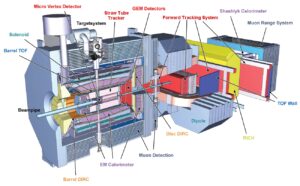Hadron Physics
PANDA
PANDA is one of the pillar experiments at the new international FAIR accelerator complex for the research with antiprotons and ions in Darmstadt. FAIR is an extension of the existing Heavy Ion Research Lab (GSI) and will provide several experimental facilities. One of these is the high energy storage ring (HESR) which can store and accelerate antiprotons with beam momenta up to 15 GeV/c. PANDA is an internal experiment of the HESR with the goal of studying QCD interactions of antiprotons with proton or nuclear targets. Among others the main physics objectives of PANDA are:
The PANDA detector is very compact and will allow the precise measurement of the momenta and energies of all reaction products of the antiproton-nucleon-annihilations. The target in the interaction region is surrounded by state-of-the-art detector components allowing the following:
- efficient measurement of all reaction products across the full solid angle (4π)
- high resolution track reconstruction and momentum determination of long-lived particles
- high resolution reconstruction of the decay vertices of short-lived particles
- high resolution particle identification and calorimetry
- processing of extremely high event rates (up to 20 MHz annihilations)
A sketch with the most important detector components is shown in the figure below (click to enlarge):

Our Erlangen group is involved in the development and setup of the particle identification detectors:
With two DIRC (Detection of Internally Reflected Cherenkov light) detectors a separation of pions and kaons will be provided. At these detectors we are responsible for the photon readout devices, in particular the microchannel-plate photomultipliers (MCP-PMTs). The most spectacular R&D result with MCP-PMTs is an increase of the lifetime by a factor ~100.
For the shortly starting assembly of the Barrel DIRC more than 150 2-inch MCP-PMTs with a segmented anode plane of 8×8 pixels are needed which will be delivered over the next two years. Therefore, our main focus is currently the characterisation and quality control of these MCP-PMTs. With sophisticated measurement and analysis techniques many performance parameters of the PMTs are measured, such as quantum and collection efficiency, gain with and without magnetic field, time resolution, rate capability, and xy-scans across the active PMT surface to study dark count rates, cross talk, and other internal parameters as a function of the 64 anode pixels. The assembly of the Barrel DIRC should be finished by the end of 2024, when first beam tests with the HESR are anticipated to start.
